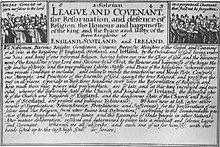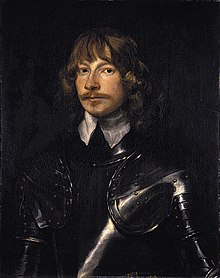Engagers
The Engagers | |
|---|---|
 A Covenanter's helmet from the period in theMuseum of Edinburgh | |
| Founded | December 1647 |
| Dissolved | 1651 |
| Split from | Covenanters |
| Religion | Presbyterianism(Church of Scotland) |
TheEngagerswere a faction of theScottishCovenanters,who made "The Engagement"with KingCharles Iin December 1647 while he was imprisoned inCarisbrooke Castleby theEnglish Parliamentariansafter his defeat in theFirst Civil War.
Background[edit]

In the 17th and 18th centuries, politics and religion were closely linked; it is impossible to understand differences between Engagers, Royalists orKirk Partypolitical views without an appreciation of these distinctions.
'Presbyterian' versus 'Episcopalian' implied differences in governance, notdoctrine.Episcopalian meant rule by bishops, appointed by the monarch; Presbyterian structures were controlled byElders,nominated by their congregations. Arguments over structure or governance of the church were as much about politics and the power of the monarch as religious practice; political divisions often centred on different interpretations of this.[1]
TheProtestant Reformationcreated aChurch of Scotland,or 'kirk', Presbyterian in structure and governance, but predominantlyCalvinistin doctrine. WhenJames VI and Ibecame king of England in 1603, a unified Church of Scotland and England governed by bishops became the first step in his vision of a centralised, Unionist state.[2]Although both churches were nominally Episcopalian, they were very different in doctrine; even Scottish bishops viewed manyChurch of Englandpractices as little better than Catholicism.[3]

Efforts byCharles Ito impose uniform practices led to the 1638National Covenant,whose signatories pledged to resist liturgical 'innovations'. In December 1638, bishops were expelled from the kirk; when Charles attempted to use military force, he was defeated in the 1639 and 1640Bishops' Wars,which left theCovenanterparty in control of Scotland.[4]
Calvinists believed a 'well-ordered' monarchy was part of God's plan; as a result, the vast majority of Covenanters agreed monarchy itself was divinely ordered but disagreed on who held ultimate authority in clerical affairs.[5]Royalists and Engagers tended to argue the king held supreme authority, but that did not necessarily mean they supported bishops and individual motives were very complex. Many fought for both Covenant and king at different times, includingMontrose.[6]
When theFirst English Civil Warbegan in 1642, Scotland initially remained neutral, but became involved in theIrish Rebellion;the bitterness of this conflict radicalised views in Scotland and Ireland.[7]The Covenanter faction known as theKirk Party,led byArgyllsaw religious union with England as the best way to preserve a Presbyterian kirk and in October 1643, theSolemn League and Covenantagreed a Presbyterian Union in return for Scottish military support.[8]
Royalists and moderates in both Scotland and England opposed union, as did the religiousIndependentslikeOliver Cromwell,who dominated theNew Model Armyand opposed any state-ordered church. Both Covenanters and their English allies saw the Independents as a bigger threat than the Royalists and when Charles surrendered in 1646, they began negotiations to restore him to the English throne.[9]
The Engagement[edit]

The Scots nominated three Commissioners to negotiate with Charles;Lauderdale,LanarkandLoudoun.In December 1647, Charles agreed to impose Presbyterianism in England for three years and suppress the Independents, but his refusal to take the Covenant himself split the Scots.[10]It was not until April 1648 the Engagers achieved a majority in theScottish Parliament;Argyll's Kirk Party did not trust Charles, objected to an alliance with English and Scots Royalists, and denounced the Engagement as 'sinful.'[11]
Most of the Scottish army had been demobilised and efforts to recruit new regiments were undermined when many refused to serve, including their most experienced generals,Lord LevenandDavid Leslie.The inexperiencedDuke of Hamiltonwas given command, with theEarl of Callendaras his subordinate. When deputy to Leven, Callendar's overestimation of his military abilities had led to constant conflict and this was repeated with Hamilton. His commander of infantry,William Baillie,had direct experience of the New Model Army and doubted their ability to defeat it.[12]
After dispersing Kirk Party dissidents atMauchline Muirin June 1648, a poorly trained Engager army of 9,000 marched into England. TheSecond English Civil Warwas intended as a series of Royalist risings in England and Wales, with the Scots providing support. By the time Hamilton's army enteredLancashirein early August, the other revolts had been suppressed and Cromwell routed the Engagers atPrestonon 19 August. Hamilton was taken prisoner and executed in March 1649.[13]
Aftermath[edit]
Defeat at Preston led to the collapse of the Engager regime; the Kirk Party took control ofEdinburghand although repulsed atStirlingin September, a new civil war seemed imminent. However, with Cromwell's support, Argyll took control and expelled his Engager opponents, with English troops being withdrawn.[13]
The 1649Act of Classesbanned Engagers and Royalists from holding political or military office and established the Kirk Party as the government of Scotland. However, the execution of Charles in January 1649 was viewed by Covenanters as an offence against God; they proclaimed his sonCharles IIKing of Scotland and Great Britain. In the 1650Treaty of Breda,they agreed to restore Charles to the English throne; in return he accepted the Covenant. Defeats atDunbarandWorcesterresulted with Scotland being incorporated into theCommonwealth of England, Scotland and Irelandin 1654.[14]
References[edit]
- ^Main, David."The Origins of the Scottish Episcopal Church".St Ninians Castle Douglas.Archived fromthe originalon 7 April 2019.Retrieved14 January2020.
- ^Stephen 2010,pp. 55–58.
- ^McDonald 1998,pp. 75–76.
- ^Mackie, Lenman & Parker 1986,pp. 204–205.
- ^Macleod 2009,pp. 5–19 passim.
- ^Harris 2015,pp. 53–54.
- ^Royle 2005,p. 142.
- ^Robertson 2014,p. 125.
- ^Royle 2005,pp. 420·423.
- ^"Gardiner: Constitutional Documents of the Puritan Revolution".Constitution Society.1 June 1999.Retrieved27 June2018.
- ^Mitchison, Fry & Fry 2002,pp. 223–224.
- ^Royle 2005,p. 424.
- ^abRoyle 2005,p. 470.
- ^Royle 2005,p. 520.
Sources[edit]
- Harris, Tim (2015).Rebellion: Britain's First Stuart Kings, 1567-1642.OUP Oxford.ISBN978-0198743118.
- McDonald, Alan (1998).The Jacobean Kirk, 1567–1625: Sovereignty, Polity and Liturgy.Routledge.ISBN185928373X.
- Mackie, JD; Lenman, Bruce; Parker, Geoffrey (1986).A History of Scotland.Hippocrene Books.ISBN978-0880290401.
- Macleod, Donald(Autumn 2009)."The influence of Calvinism on politics"(PDF).Theology in Scotland.XVI(2).
- Mitchison, Rosalind; Fry, Peter; Fry, Fiona (2002).A History of Scotland.Routledge.ISBN978-1138174146.
- Robertson, Barry (2014).Royalists at War in Scotland and Ireland, 1638–1650.Ashgate.ISBN978-1409457473.
- Royle, Trevor (2005).Civil War: The War of the Three Kingdoms 1638-1660.Abacus.ISBN0349115648.
- Stephen, Jeffrey (January 2010). "Scottish Nationalism and Stuart Unionism".Journal of British Studies.49(1, Scottish Special).doi:10.1086/644534.S2CID144730991.
External links[edit]
- Plant, David (1 November 2008)."The Engagement, 1647-8".BCW Project.Retrieved27 June2018.
- "Gardiner: Constitutional Documents of the Puritan Revolution".Constitution Society.1 June 1999.Retrieved27 June2018.
